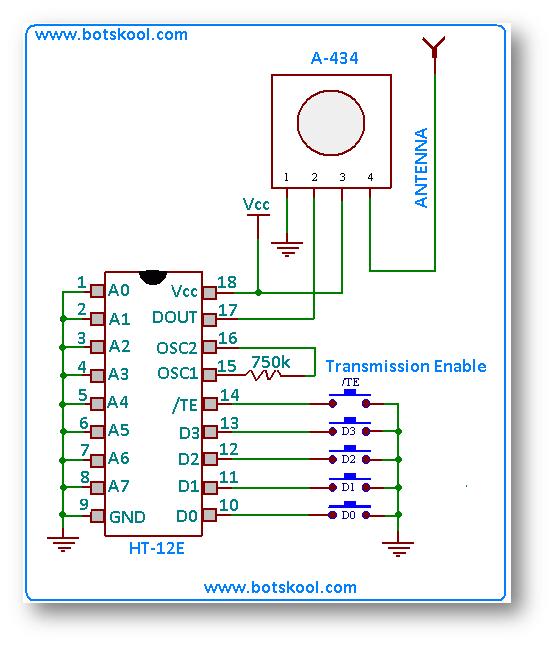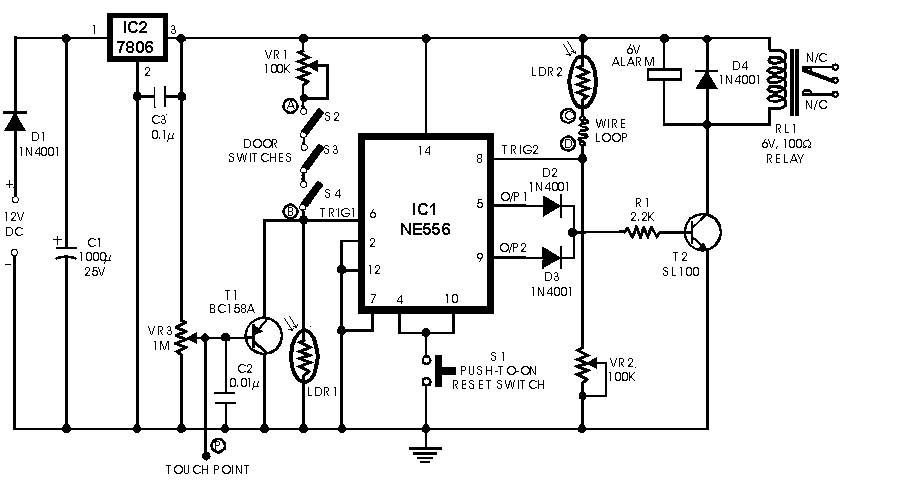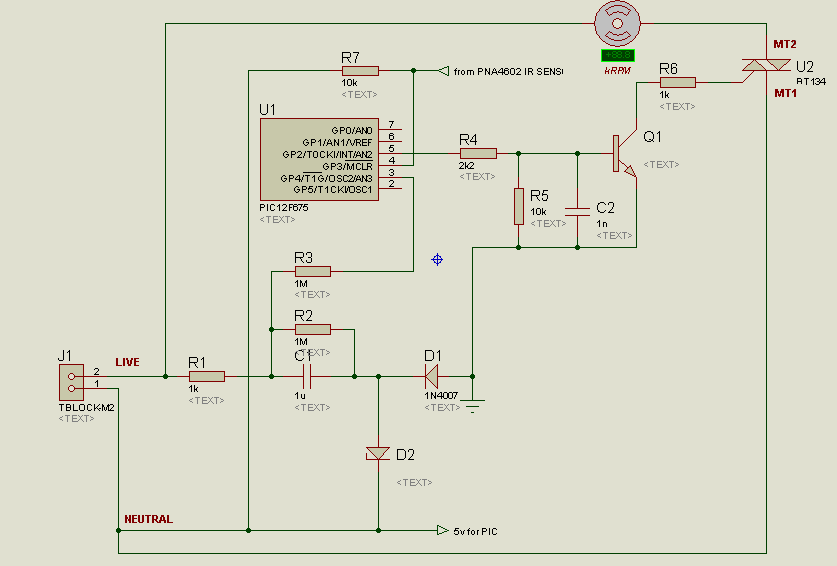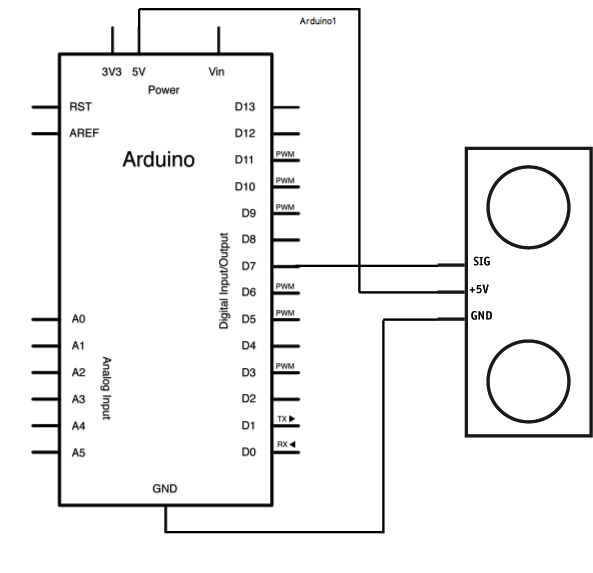
Digital sound and light control stairs delay switching circuit

The CDI011 integrated circuit is designed for a sound and light-controlled stair delay switch circuit, which is relatively simple and effective. It utilizes a combination of NAND gates and differential input dynamics. The circuit has two input terminals; when the first terminal is at a high level, the output terminal remains high, allowing for VDI conduction and capacitor charging. This is achieved through two inverting outputs. When triggered, a thyristor (VT2) is activated, powering a lamp (E). If the first terminal goes low, the circuit will not meet the conditions for lighting the lamp. The first terminal is controlled by a resistor (R) and a light-dependent resistor (RL), which only allows activation at night due to high resistance. The microphone amplifier (VT1) is used to detect audio signals. Under normal conditions, VT1 does not output audio. However, when footsteps are detected on the stairs, VT1 amplifies the signal, causing the collector voltage to rise. If the first terminal goes high, the lamp (E) lights up. When the audio signal disappears, the circuit maintains a high level at the first terminal, enabling a delay circuit that keeps the light on for a specified duration.
The CDI011 integrated circuit functions as a sound and light control mechanism for stairway illumination, enhancing safety and convenience in low-light conditions. The circuit architecture employs a combination of digital logic components, specifically NAND gates, to achieve the desired operational characteristics.
The input stage comprises two terminals, with the first terminal (referred to as O) designed to respond to high and low voltage levels. When the O terminal is high, it triggers the output, allowing current to flow through the thyristor (VT2), which subsequently energizes the lamp (E). The conduction path for the lamp is established when the voltage at the output terminal is maintained high, indicating that the circuit is in an active state.
The integration of a light-dependent resistor (RL) plays a crucial role in the circuit's operation, ensuring that the system is only responsive during nighttime conditions. The high resistance of RL in low light allows the O terminal to remain high, thereby meeting the necessary conditions for circuit activation.
The microphone amplifier (VT1) serves as a critical sensor, detecting ambient sounds, particularly footsteps on the stairs. Under normal conditions, VT1 remains inactive, but when sound is detected, it amplifies the audio signal, resulting in a voltage increase at its collector. This transition is pivotal, as it allows the O terminal to achieve a high state, thus activating the lamp.
The circuit also incorporates a delay mechanism, which ensures that the light remains illuminated for a predetermined duration after the audio signal ceases. This is achieved through a capacitor (C2) that discharges gradually, providing a time delay before the circuit resets to its original state. The design parameters for the delay are influenced by the capacitance value of C2, which can be adjusted to meet specific timing requirements.
Overall, the CDI011 integrated circuit offers an efficient solution for stairway lighting control, utilizing sound detection and light sensitivity to enhance user safety in dimly lit environments.CDI011 integrated circuits using sound, light control stairs delay switch circuit is relatively simple, Pi can be good. Scarf, and non-f JI and NAND f JlI constitution "and" r J circuit, differential input dynamic.
Only two input terminals that is the first O, feet are at the high level, the output terminal feet high before, VDI conduction, C: charging. And through the door and door s t two inverting outputs a high level} U, and then R, triggered thyristor VT2 opened, the lamp E powered light.
Input terminals O, feet as long as there is a low level, the circuit can not meet the above conditions, credits lamp will be lit. O feet by R. And RL partial pressure control, only at night, photosensitive resistance Rl. High resistance, O feet high in order to meet the conditions. feet by the microphone amplifier VT1 Hj lose control, usually the letter H no audio outputs, VT1 in zoom mode, feet f-what level is low (adjusted R: collecting food to make it level lower than the threshold circuit flip smell electrical values level, namely 1,, 2V ..), when someone walking the aisle stairs, their footsteps pickup signal by B, VT1 zoom, make VT1 collector set and foot level rises.
The "meet O, feet high, the electric light E lights up when people would run away, the audio signal disappears, c store lb load by foot; discharge, can still maintain, a feet is high level, the trap circuit enables lu lights off delay. the delay circuit when l asked Feng to the brother, it decided c2 values shown data about imin so.
The CDI011 integrated circuit functions as a sound and light control mechanism for stairway illumination, enhancing safety and convenience in low-light conditions. The circuit architecture employs a combination of digital logic components, specifically NAND gates, to achieve the desired operational characteristics.
The input stage comprises two terminals, with the first terminal (referred to as O) designed to respond to high and low voltage levels. When the O terminal is high, it triggers the output, allowing current to flow through the thyristor (VT2), which subsequently energizes the lamp (E). The conduction path for the lamp is established when the voltage at the output terminal is maintained high, indicating that the circuit is in an active state.
The integration of a light-dependent resistor (RL) plays a crucial role in the circuit's operation, ensuring that the system is only responsive during nighttime conditions. The high resistance of RL in low light allows the O terminal to remain high, thereby meeting the necessary conditions for circuit activation.
The microphone amplifier (VT1) serves as a critical sensor, detecting ambient sounds, particularly footsteps on the stairs. Under normal conditions, VT1 remains inactive, but when sound is detected, it amplifies the audio signal, resulting in a voltage increase at its collector. This transition is pivotal, as it allows the O terminal to achieve a high state, thus activating the lamp.
The circuit also incorporates a delay mechanism, which ensures that the light remains illuminated for a predetermined duration after the audio signal ceases. This is achieved through a capacitor (C2) that discharges gradually, providing a time delay before the circuit resets to its original state. The design parameters for the delay are influenced by the capacitance value of C2, which can be adjusted to meet specific timing requirements.
Overall, the CDI011 integrated circuit offers an efficient solution for stairway lighting control, utilizing sound detection and light sensitivity to enhance user safety in dimly lit environments.CDI011 integrated circuits using sound, light control stairs delay switch circuit is relatively simple, Pi can be good. Scarf, and non-f JI and NAND f JlI constitution "and" r J circuit, differential input dynamic.
Only two input terminals that is the first O, feet are at the high level, the output terminal feet high before, VDI conduction, C: charging. And through the door and door s t two inverting outputs a high level} U, and then R, triggered thyristor VT2 opened, the lamp E powered light.
Input terminals O, feet as long as there is a low level, the circuit can not meet the above conditions, credits lamp will be lit. O feet by R. And RL partial pressure control, only at night, photosensitive resistance Rl. High resistance, O feet high in order to meet the conditions. feet by the microphone amplifier VT1 Hj lose control, usually the letter H no audio outputs, VT1 in zoom mode, feet f-what level is low (adjusted R: collecting food to make it level lower than the threshold circuit flip smell electrical values level, namely 1,, 2V ..), when someone walking the aisle stairs, their footsteps pickup signal by B, VT1 zoom, make VT1 collector set and foot level rises.
The "meet O, feet high, the electric light E lights up when people would run away, the audio signal disappears, c store lb load by foot; discharge, can still maintain, a feet is high level, the trap circuit enables lu lights off delay. the delay circuit when l asked Feng to the brother, it decided c2 values shown data about imin so.





